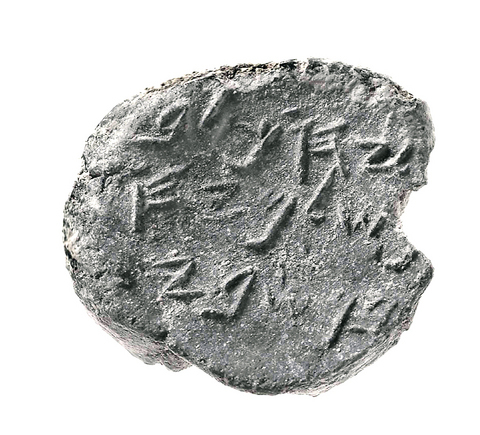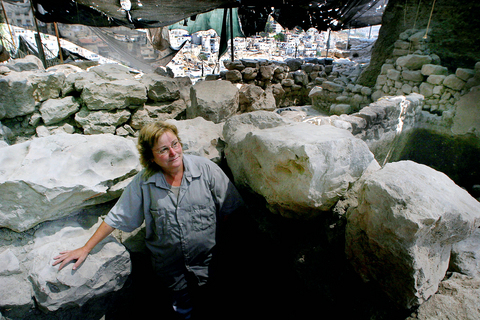An Israeli archaeologist says she has uncovered in East Jerusalem what may be the fabled palace of the biblical King David. Her work has been sponsored by a conservative Israeli research institute and financed by an American Jewish investment banker who would like to prove that Jerusalem was indeed the capital of the Jewish kingdom described in the Bible.
Other scholars are skeptical that the foundation walls discovered by the archaeologist, Eilat Mazar, are David's palace. But they acknowledge that what she has uncovered is rare and important: a major public building from around the 10th century BC, with pottery shards that date to the time of David and Solomon and a government seal of an official mentioned in the book of Jeremiah. The discovery is likely to be a new salvo in a major dispute in biblical archaeology: whether the kingdom of David and Samuel was of some historical magnitude, or whether the men were more like small tribal chieftains, reigning over another dusty hilltop.
The find will also be used in the broad political battle over Jerusalem -- whether the Jews have their origins here and thus have some special hold on the place, or whether, as many Palestinians have said, including the late Yasser Arafat, the idea of a Jewish origin in Jerusalem is a myth used to justify conquest and occupation. Hani Nur el-Din, a Palestinian professor of archaeology at Al Quds University, said he and his colleagues considered biblical archaeology an effort by Israelis "to fit historical evidence into a biblical context."

He added, "The link between the historical evidence and the biblical narration, written much later, is largely missing. There's a kind of fiction about the 10th century. They try to link whatever they find to the biblical narration. They have a button, and they want to make a suit out of it."
Even Israeli archaeologists are not so sure that Mazar has found the palace -- the house that Hiram, king of Tyre, built for the victorious king, at least as Samuel 2:5 describes it. It may also be the Fortress of Zion that David conquered from the Jebusites, who ruled Jerusalem before him, or some other structure about which the Bible is silent. Either way, they are impressed by its likely importance.
"This is a very significant discovery, given that Jerusalem as the capital of the united kingdom is very much unknown," said Gabriel Barkay, an archaeologist from Bar-Ilan University.

PHOTO: NY TIMES
"This is one of the first greetings we have from the Jerusalem of David and Solomon, a period which has played a kind of hide-and-seek with archaeologists for the last century."
Based on the Bible and a century of archaeology in this spot, Mazar, 48, speculated that a famous stepped-stone structure excavated previously was part of the fortress David conquered, and that his palace would have been built just outside the original walls of the cramped city, on the way to what his son, Solomon, built as the Temple Mount.
"When the Philistines came to fight, the Bible said that David went down from his house to the fortress," she said, her eyes bright. "I wondered, down from where? Presumably from where he lived, his palace."
"So I said, maybe there's something here," she added, referring to East Jerusalem. David's palace was the topic of a last conversation Mazar had with her grandfather, Benjamin Mazar, a famous archaeologist who helped to train her and who died 10 years ago. Five months ago, with money and permission from the Ir David Foundation, which controls the site (and supports Jews moving into East Jerusalem), she finally began to dig. Amihai Mazar, a professor of archaeology at Hebrew University, calls the find "something of a miracle."
He says he believes that the building may be the Fortress of Zion that David is said to have conquered, which he renamed the City of David.
"What she found is fascinating, whatever it is," he said. Amihai Mazar is Eilat Mazar's second cousin, but he has his own reputation to protect. Archaeologists debate "to what extent Jerusalem was an important city or even a city in the time of David and Samuel," he said.
"Some believe it was tiny and the kingdom unimportant."
The site of ancient Jerusalem, stuck between two valleys on a ridge south of the Temple Mount, is very small, less than 10 acres. Israel Finkelstein, another renowned archaeologist, has suggested that without significant evidence, Jerusalem in this period was "perhaps not more than a typical hill-country village."
In his book, The Bible Unearthed, Finkelstein writes with Neil Silberman, "Not only was any sign of monumental architecture missing, but so were even simple pottery shards."
The building can be reasonably dated by the pottery found above and below it. Mazar found on the bedrock a large floor of crushed limestone, indicating a large public space. The floor and fill above it contain pottery from Iron Age I of the 12th to 11th centuries BC, just before David conquered Jerusalem. Above that, Mazar found the foundations for this monumental building, with large boulders for walls that are more than 1.8m thick and extend at least 30m. In one corner was pottery from Iron Age 2, the 10th to 9th centuries, roughly the time of the united kingdom. Unfortunately, Amihai Mazar said, she found no floor. It is clear the building was constructed after the pottery underneath it, but less clear exactly how much later.
The archaeological debate is also partly a debate over the roots of Zionism and the effort to find Jewish origins deep in the land. Eilat Mazar's latest dig, which has cost about US$500,000, has been sponsored by Roger Hertog, a New York financier who is vice chairman of Alliance Capital Management. Hertog, who owns a piece of The New York Sun and The New Republic, is also chairman of the board of the Shalem Center in Jerusalem, where Mazar is a senior fellow.
The Shalem Center was founded as Israel's first "neoconservative think-tank," said William Kristol, who is also on the board, in an effort to give the Israeli right a better foundation in history, economics, archaeology and other topics. Hertog calls his investment in Mazar "venture philanthropy -- you have the opportunity for intellectual speculation, to fund something that is a work of great consequence." He said he hoped to show "that the Bible reflects Jewish history."
Mazar continues to dig, but right now, three families are living in houses where she would most like to explore. One family is Muslim, one Christian and one Jewish.

In late October of 1873 the government of Japan decided against sending a military expedition to Korea to force that nation to open trade relations. Across the government supporters of the expedition resigned immediately. The spectacle of revolt by disaffected samurai began to loom over Japanese politics. In January of 1874 disaffected samurai attacked a senior minister in Tokyo. A month later, a group of pro-Korea expedition and anti-foreign elements from Saga prefecture in Kyushu revolted, driven in part by high food prices stemming from poor harvests. Their leader, according to Edward Drea’s classic Japan’s Imperial Army, was a samurai

The following three paragraphs are just some of what the local Chinese-language press is reporting on breathlessly and following every twist and turn with the eagerness of a soap opera fan. For many English-language readers, it probably comes across as incomprehensibly opaque, so bear with me briefly dear reader: To the surprise of many, former pop singer and Democratic Progressive Party (DPP) ex-lawmaker Yu Tien (余天) of the Taiwan Normal Country Promotion Association (TNCPA) at the last minute dropped out of the running for committee chair of the DPP’s New Taipei City chapter, paving the way for DPP legislator Su

It’s hard to know where to begin with Mark Tovell’s Taiwan: Roads Above the Clouds. Having published a travelogue myself, as well as having contributed to several guidebooks, at first glance Tovell’s book appears to inhabit a middle ground — the kind of hard-to-sell nowheresville publishers detest. Leaf through the pages and you’ll find them suffuse with the purple prose best associated with travel literature: “When the sun is low on a warm, clear morning, and with the heat already rising, we stand at the riverside bike path leading south from Sanxia’s old cobble streets.” Hardly the stuff of your

April 22 to April 28 The true identity of the mastermind behind the Demon Gang (魔鬼黨) was undoubtedly on the minds of countless schoolchildren in late 1958. In the days leading up to the big reveal, more than 10,000 guesses were sent to Ta Hwa Publishing Co (大華文化社) for a chance to win prizes. The smash success of the comic series Great Battle Against the Demon Gang (大戰魔鬼黨) came as a surprise to author Yeh Hung-chia (葉宏甲), who had long given up on his dream after being jailed for 10 months in 1947 over political cartoons. Protagonist